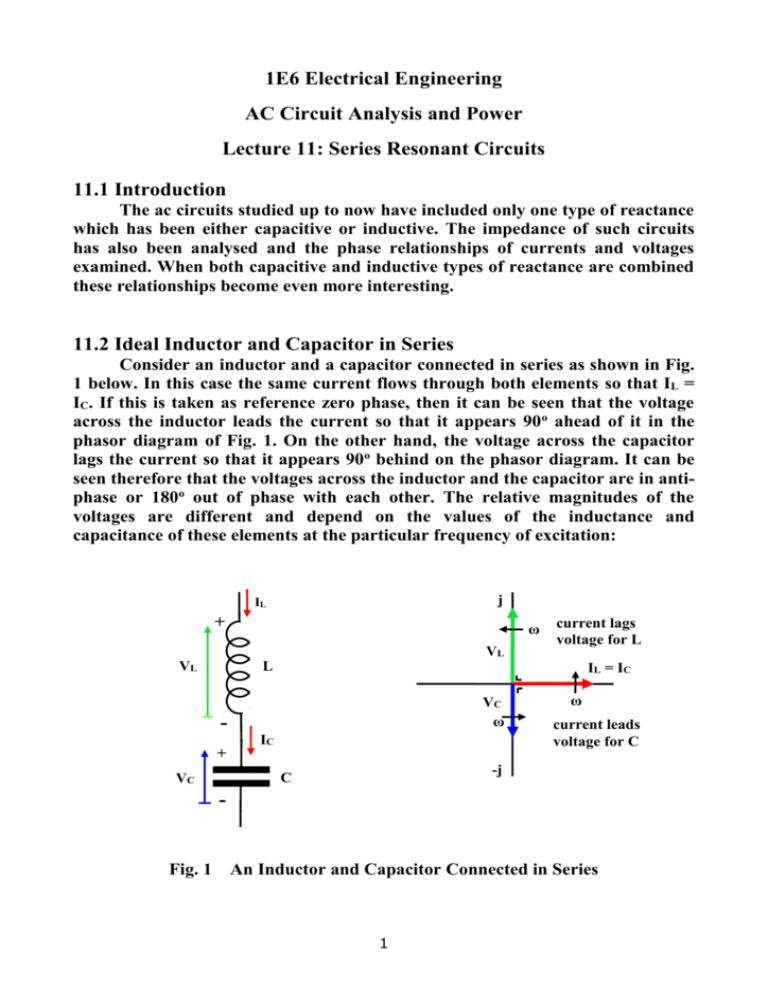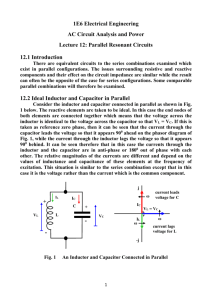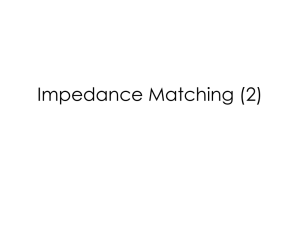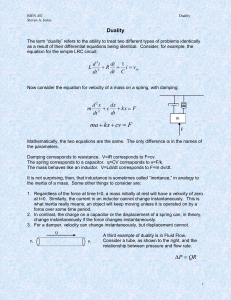Lecture 11 Series Resonant Circuits
advertisement

1E6 Electrical Engineering AC Circuit Analysis and Power Lecture 11: Series Resonant Circuits 11.1 Introduction The ac circuits studied up to now have included only one type of reactance which has been either capacitive or inductive. The impedance of such circuits has also been analysed and the phase relationships of currents and voltages examined. When both capacitive and inductive types of reactance are combined these relationships become even more interesting. 11.2 Ideal Inductor and Capacitor in Series Consider an inductor and a capacitor connected in series as shown in Fig. 1 below. In this case the same current flows through both elements so that IL = IC. If this is taken as reference zero phase, then it can be seen that the voltage across the inductor leads the current so that it appears 90o ahead of it in the phasor diagram of Fig. 1. On the other hand, the voltage across the capacitor lags the current so that it appears 90o behind on the phasor diagram. It can be seen therefore that the voltages across the inductor and the capacitor are in antiphase or 180o out of phase with each other. The relative magnitudes of the voltages are different and depend on the values of the inductance and capacitance of these elements at the particular frequency of excitation: j IL + ω VL current lags voltage for L L VL IL = IC VC ω IC + current leads voltage for C -j C VC ω - Fig. 1 An Inductor and Capacitor Connected in Series 1 IL , IC j VL VC ω IL , IC VC ω t ω VL -j Fig. 2 Phasor Diagram and Waveforms for Inductor and Capacitor in Series Waveforms are shown for sinusoidal excitation of the circuit in Fig. 2. From this it is clearly evident that the phasors representing the voltages across the inductor and the capacitor are exactly 1800 out of phase, showing excursions on opposite sides of the abscissa axis. The difference in the amplitudes depends on the relative magnitudes of the impedances as functions of frequency and hence also on the values of inductor and capacitor used. The impedance of the series combination can be found in the normal manner. As the elements are in series, the currents through both elements are identical and the voltage drop across the series combination is the sum of the voltage drops across the individual elements. Then the impedance is given as: Ζ Then: v(t) i(t) v(t) vL(t) vC(t) where vL(t) vC(t) vL(t) vC(t) Ζ Z L ZC i(t) i(t) i(t) 1 1 Ζ jL j j L ωC ωC It can be seen that the overall impedance of the network is purely reactive with no resistance, in the case of the ideal inductor and capacitor implied in Fig. 1. Given the nature of the above expression, there is clearly a value of frequency for which the expression is zero. 2 This can be found as: L 1 0 ωC L 1 ωC 2 1 LC 0 1 LC The value of this frequency, referred to in practice as the resonant frequency, depends entirely of the values of the components used. This result implies that at this frequency the impedance of the series combination is zero in the case of ideal components. The magnitude of the impedance is given as: Z L 1 ωC ¦Z¦ ω0 0 ω Fig. 3 The Magnitude of the Impedance as a Function of Frequency 3 This is shown plotted as a function of frequency in general form in Fig. 3. It can be seen that the impedance is very high at high and low frequencies. It becomes zero at the resonant frequency ω = ω0. IL , IC j VC ω0 VL IL , IC VC ω0 t ω0 VL -j Fig. 4 Phasors / Waveforms for Series Inductor and Capacitor at Resonance In essence, at the resonant frequency the effect of the inductive reactance cancels the capacitive reactance. Therefore the same current develops voltages with equal magnitude and opposite polarity at the resonant frequency and the net effect is zero voltage or potential drop across the combined series combination, giving the resultant net impedance of zero as shown in Fig. 3. It must be noted, however, that the individual voltages across each element are not zero as can be seen in Fig. 4 where the phasor diagram and waveforms are shown at the resonant frequency. The precise magnitudes of the voltages across the capacitor and the inductor depend on the values of these components, the inductance in Henrys and the capacitance in Farads. 11.3 Resistance, Inductor and Capacitor in Series Fig. 5 shows a resistor added in series with the previous inductor and capacitor connected in series. Again, the same current flows through all of the elements so that IL = IC = IR. The same relationships hold between voltage and current in the inductor and the capacitor so their phase relationships are unaltered. The voltage across the resistor is in phase with the current flowing through it so their phasors appear superimposed in Fig. 5. However, in this case the impedance has an added element in the resistor which is present. The net voltage across the circuit is the vector sum of the three individual components so that the impedance is given as: Ζ v(t) i(t) where v(t) v L (t) v C (t) v R (t) 4 IL + L VL j ω - VL IC current lags voltage for L IL = IC = IR + C VC VC ω IR + ω VR current leads voltage for C -j R VR Fig. 5 A Resistor, Capacitor and Inductor, RLC, Connected in Series Then: v L (t) v C (t) v R (t ) v L (t) v C (t) v R (t ) Ζ i(t) i(t) i(t) i( t ) 1 Ζ Z L Z C Z R j L j R C so that: 1 Ζ R j L ωC In this case it can be seen that the impedance is truly complex, having a real part and an imaginary part. The real part is the resistance while the imaginary part is reactive. The reactive part can be dominated by the inductive reactance or the capacitive reactance depending on the values of these components and the frequency of operation. The impedance therefore has an associated magnitude and phase given as: 5 1 2 Ζ R L ωC 2 1 L ωC Z Tan 1 R The values of both the magnitude and phase depend on the values of all of the components as well as the frequency. At the frequency ω = ω0 having the same value as above the impedance has its minimum value. This time, however, while the reactive component becomes zero the impedance remains finite at the value of the resistance, R. ¦Z¦ R ω0 0 ω Fig.6 The Magnitude of the Impedance of the Series RLC Combination Note that the net resultant voltage developed across the combined series combination is given as: v(t) v L (t) v C (t) v R (t) i(t )Z i(t ) Z Z If the current phasor is taken as the reference zero phase vector then the magnitude and phase of the resultant voltage across the series RLC combination is given as: 6 v(t) i(t )Z I Z Z where I is the magnitude of the current. Then the magnitude and phase of the resultant voltage are obtained as: 1 2 v(t ) I R L ωC 2 1 L ωC V Tan 1 R A plot of the phasor diagram which includes the resultant voltage across the series combination is shown in Fig. 7 for particular values of components and a particular frequency. Note that the resultant net voltage across the series combination has a magnitude and phase which depends on all three components and can lead or lag the current depending on whether the net reactance is inductive or capacitive. IL , IC, IR j V ω VC V VL IL, IC, IR VC ω VR t ω VL -j Fig. 7 Phasor Diagram and Waveforms for Series RLC Combination 7 11.4 Application One application of a series LC circuit is the IF Trap in a superheterodyne radio receiver as illustrated in Fig. 8 below. The standard domestic AM/FM radio is such a receiver. This type of radio receiver applies a vast amount of gain to the signal picked up at the aerial in an intermediate frequency or IF stage. The intermediate frequency is chosen to lie outside the reception band of the radio. However, if a signal at this IF frequency is picked up at the aerial it can interfere severely with reception of the wanted signal. Therefore an IF Trap is included in the form of a series LC circuit which has a resonant frequency equal to the intermediate frequency. The winding of the aerial coil forms the inductance of the series circuit and its resonance with a selected capacitor value gives a near zero impedance at the IF. Therefore any signal at this frequency appearing at the aerial is shunted to ground and does not develop any detectable voltage at the input of the RF amplifier. aerial RF Amplifier IF Trap Fig. 8 A Series LC Circuit as an IF Trap in a Radio Receiver 8








